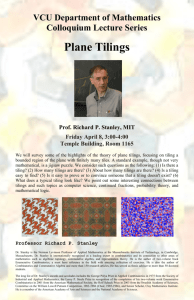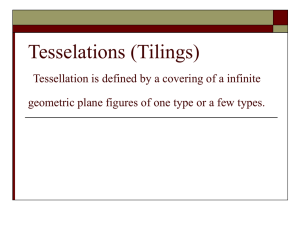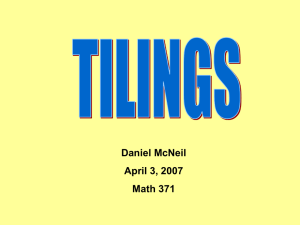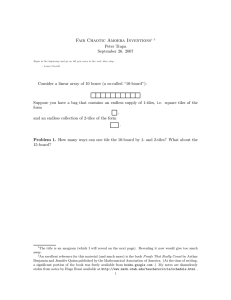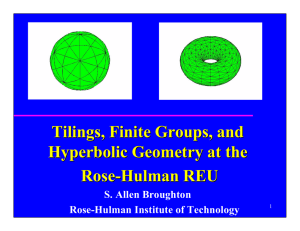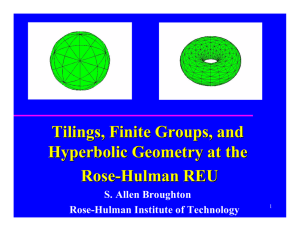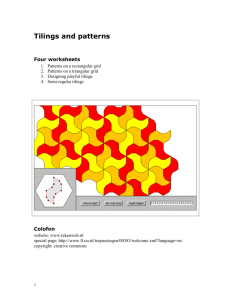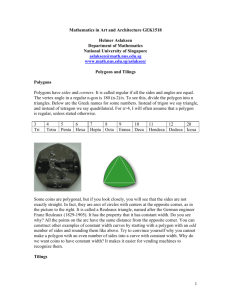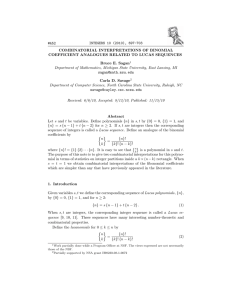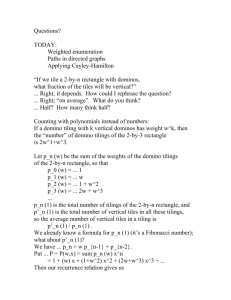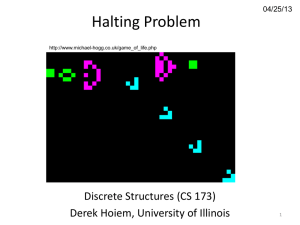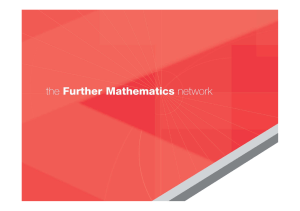Daily summary
advertisement
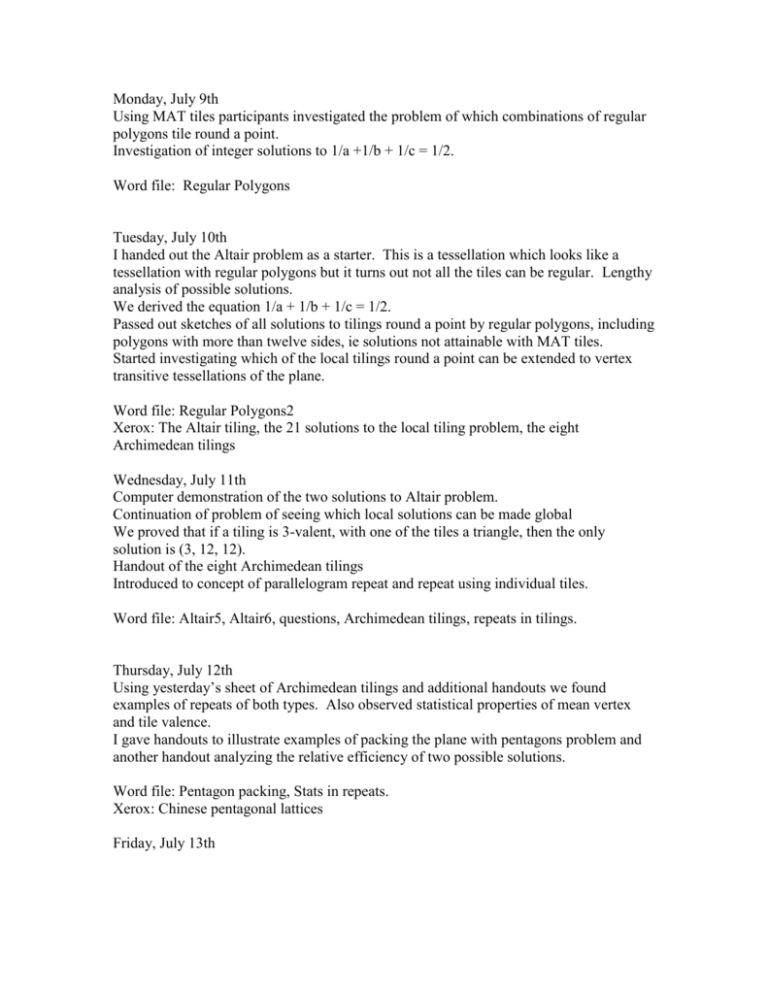
Monday, July 9th Using MAT tiles participants investigated the problem of which combinations of regular polygons tile round a point. Investigation of integer solutions to 1/a +1/b + 1/c = 1/2. Word file: Regular Polygons Tuesday, July 10th I handed out the Altair problem as a starter. This is a tessellation which looks like a tessellation with regular polygons but it turns out not all the tiles can be regular. Lengthy analysis of possible solutions. We derived the equation 1/a + 1/b + 1/c = 1/2. Passed out sketches of all solutions to tilings round a point by regular polygons, including polygons with more than twelve sides, ie solutions not attainable with MAT tiles. Started investigating which of the local tilings round a point can be extended to vertex transitive tessellations of the plane. Word file: Regular Polygons2 Xerox: The Altair tiling, the 21 solutions to the local tiling problem, the eight Archimedean tilings Wednesday, July 11th Computer demonstration of the two solutions to Altair problem. Continuation of problem of seeing which local solutions can be made global We proved that if a tiling is 3-valent, with one of the tiles a triangle, then the only solution is (3, 12, 12). Handout of the eight Archimedean tilings Introduced to concept of parallelogram repeat and repeat using individual tiles. Word file: Altair5, Altair6, questions, Archimedean tilings, repeats in tilings. Thursday, July 12th Using yesterday’s sheet of Archimedean tilings and additional handouts we found examples of repeats of both types. Also observed statistical properties of mean vertex and tile valence. I gave handouts to illustrate examples of packing the plane with pentagons problem and another handout analyzing the relative efficiency of two possible solutions. Word file: Pentagon packing, Stats in repeats. Xerox: Chinese pentagonal lattices Friday, July 13th We analyzed possible complexes of types of rotational symmetry in a periodic tiling. We used the Archimedean tilings, an additional handout and reproductions of MC Escher’s work to find repeats and rotocentres. Demonstrated the crystallographic restriction. Word files: symmetry in tilings Xerox: Repeats in tilings, symmetry in tilings Monday, July 16th I used a handout generated in Tessellation Exploration of Escher’s Lizards design to explore further repeats and rotocentres. Handouts of the Texas tiling, Scott Kim’s Tessellation font, rotationally symmetric table music and transformations to be found in Bach’s fugues. Word file: Tess font Xerox: Escher’s Lizard tiling, Texas tiling, rotationally symmetric table music, transformations in Bach fugues Tuesday, July 17th We generated the seven one-dimensional frieze patterns. Handout of an exercise to design an example of each of the seven. I showed overheads of the graphic work of Scott Kim and John Langdon and other examples of symmetry (eg crossword puzzle grids). Word file: Frieze patterns Wednesday, July 18th Non-repeating tilings. We played the a, b game and looked at regularities and quasiperiodicity. We dissected the L-tetromino and I showed how the decomposition and recomposition could lead to an aperiodic tiling. I introduced Penrose’s aperiodic rhombs and handed out two sheets of rhombs. Participants played with Pentaplex’s aperiodic plastic chickens. Word file: Penrose, The a, b Game Xerox: Packet on Penrose tilings, examples of Penrose rhombs Thursday, July 19th I demonstrated my tiling using four of the sheets of Penrose rhombs. With 3-D Geoshapes, participants built tetrahedral and octahedral to investigate the ratio of tetrahedral to octahedral needed to build higher frequency tetrahedral. They generalized the numbers to n-frequency tetrahedral and found the limit to be two tetrahedra to each octahedra. Word file: Tetrahedra Etcetera Friday, July 20th I showed models built in Ramagons illustrating tetrahedra and octahedra in the jib of a crane and Buckminster Fuller’s Octet Truss. Participants built models of a cuboctahedron after cutting out four hexagons and assembling them with bobby pins. Word file: More Polyhedra, Bucky’s cuboctahedron Monday, July 23rd I showed how the name of the cuboctahedron was derived using a model of an interpenetrating cube and octahedron. We took up the problems of the square lattice and cubic lattice in which alternate cells take over neighbouring cells, producing the square tessellation and the rhombic dodecahedron respectively. Participants built a rhombic dodecahedron using Zometool and investigated some of its properties. The rhombic dodecahedron will be the subject of a presentation by two participants from the geometry working group. Word file: Rhombic dodecahedron Tuesday, July 24th Participants investigated some properties of the regular tetrahedron and locus problems in space in a worksheet. Word file: Some cubic questions Wednesday, July 25th I demonstrated a Zometool model of the crystal structure of diamond to make the connection between the rhombic dodecahedron and chemistry. I posed the problem of the areas and perimeters of cross-sections of a regular tetrahedron. We made a connection with a sequence of rectangles whose length and widths increased and decreased respectively by one and the tetrahedral numbers (n choose 3) in Pascal’s Triangle. Participants continued with the investigation of the locus of points equidistant from the centre of a cube and its vertices and the more general problem of the locus of points equidistant from the points of the cubic-centred lattice. I showed models of the cube and the octahedron and truncated octahedron that form the required loci. Then I showed a model of nine close-packed truncated octahedra at the centre and vertices of a cube to show that this polyhedron fills space and also models the close-packing of cells in a dry foam. Word file: Tetrahedron Cross-sections, Some Cubic Questions
